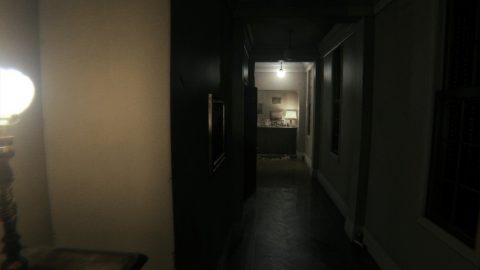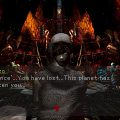“Playable Teaser”; that’s what P.T. stands for. A short interactive look at something coming in the future. Not even a slice of the game in production, but an idea, a concept, a sketch for what it might be. Released with little fanfare in 2014 on the PlayStation 4, the game sparked a whole litany of excitement, once it was revealed that a new Silent Hill was in development. Then, in less than a year, it was gone, and the game it teased was canceled in the wake of the very messy and public divorce of Kojima Productions and Konami. The idea of short horror vignettes and unkillable stalker enemies in games was nothing new; the PC was littered with both before P.T. released. However, its photorealism, repetitive structure, and powerful sense of terror & mystery captured the imaginations of many, and being eradicated from download certainly didn’t hurt its popularity either. Much like Resident Evil 4 in 2000s, P.T. is an inescapable influence on survival horror today.
Rumblings of another Silent Hill game began after the release of Silent Hill: Downpour in 2012. Hideo Kojima passingly mentioned that Konami higher-ups asked him to make a new game in the series, to which he demurred on being a good fit for it but was interested in doing nonetheless. Series alumni, like Masahiro Ito and Akira Yamaoka, expressed interest in working with the famous director as well. Nothing concrete materialized for sometime. Then, in August 2014, an unknown developer named 7780s Studios released P.T. on PSN. The game had no outward references to the series, outside of sharing a common name of Lisa. Clever folks figured out that the name of the studio referenced the nickname for the series, being the square kilometers of a Japanese prefecture, Shizuoka, or literally in English, ‘quiet hills.’ It was only after completion that it plays a short trailer for “Silent Hills,” a new game being made by Kojima and Guillermo del Toro, starring Norman Reedus, using the Fox Engine from Metal Gear Solid V. Oh and Junji Ito was in talks to be brought on for monster design. It would have been an unprecedented level of collaboration between modern masters of horror, had it been made.
Beginning in a nondescript concrete room with only one door out, P.T. unfolds in a series of loops through a right angle hallway in an unknown house. The hallway is initially just dilapidated and dirty, with half eaten candy bars wrappers, wine bottles strewn around, and cockroaches crawling on the walls, but it becomes more threatening in each successive loop. A tall woman with a creepy smile stalks the player and should they cross paths with her, then it is back to the concrete room to start the same loop again. Observing the hallway and reacting to its changes are the ways to make progress through each loop, and goodness does it change. The chandelier in the foyer is replaced by a refrigerator leaking blood out of it. A door opens up to reveal a filthy bathroom with a crying kind-of-fetus creature in it. At one point, the hallway literally becomes endless, no entrances or exits, bathed in a red light and picture frames filled with vibrating human eyes, as the player runs at a full sprint through it.
The puzzles come up throughout loops have quite a range from simple to obscure. On one loop, the exit door is locked and careful observation will discover one of the framed pictures found throughout the hallway has changed. On the picture is written the phrase “Gouge it out!” with an X drawn underneath the woman in the photo. Hitting the X button gouges her right eye out, unlocking the way forward. Another loop traps the player in the bathroom after they pick up the flashlight and wait patiently while there is banging on the door. Meant to be difficult to finish on purpose, the final puzzle of the game relies on a set of esoteric actions the player must take to trigger three baby laughs, all only by flashlight and while being stalked. One of these actions even surreptitiously requires the use of a microphone. Despite this, the game was completed on release day; Kojima expected that it would take about a week to work through the mystery. It is a short experience, taking maybe a couple of hours at most. An optional puzzle involves collecting six small photo fragments hiding around the room — and even the options menu — to complete a picture. Finding each one nebulously hints at the solution to the final puzzle, if you know six different languages.
The mark of good surrealism and horror is the plausibility of something completely unreal. It’s the process by which something as banal as moving through a hallway becomes a disquieting and unsettling experience. The repeated hallway is a place that violates all logic and reason, yet it is meticulously rendered to look real; the raindrops pooling on the windows, the reflections of the flashlight off the mirror in the bathroom, the texture of the grimy walls and the cockroaches skittering across them. This realism extends to the sound as well; the groan of the door opening and closing and slamming shut, the creek of the chandelier as it sways gently in the foyer, the baby’s cry from the other side of the bathroom door. It’s an intense experience that feels believable. It prefigured the rise of VR horror and how the simple illusions of presence and realism can be twisted to evoke fear.
Central to this game’s fear is Lisa, the tall woman stalking the player throughout the teaser and whose picture is reconstructed in the optional puzzle. The wounds she carries, a missing right eye and blood emanating from her stomach, match the radio report describing the murder of a woman and her child by her husband. After her first chilling reveal, she randomly stalks the player throughout the hallway. She can be found waiting at the exit and entrance doors, inside the bathroom, and popping up outside the three windows in the hallway, ready to give a scare. She twitches unnaturally when she shuffles toward the player, and when she attacks, she snap his neck. She is able to possess the player, following close, adding an extra footstep, and leaving hints of her shadow on the wall. She is inflicting justice for the misogynistic destruction done to her, in direct ways, even from beyond the grave.
The magic of surrealism is that it is up to interpretation. and P.T. inspired a whole smorgasbord of that. Its confounding structure and vague, disturbing imagery invite not only the expected terrified reaction video from streamers, but also deep dives into the lore, symbolism, and narrative that power the game, akin to other Silent Hill games. Others have used the power of modded PS4s to peer behind the veil, finding out how Lisa comports herself during her frights and getting a closer look at the incomplete, but still detailed, model of the town seen in the trailer. Others took the cancellation to make their own clones of the teaser, in Unity and Unreal Engine, only to be taken down with DMCAs. What Konami wanted to abandon was embraced by other publishers. Resident Evil VII went in a first person, photorealisitic direction, and the game was introduced through a series of mysterious demos to great success in 2017. The 2021 sequel, Resident Evil Village, featured an extended sequence that echoes P.T. even more directly.
And it doesn’t take long to search Itch.io or Steam to see how it has resonated with indie developers. Visage, out of early access in October 2020, expands on the concept of exploring a spooky, run down house that require patient observation to survive and unravel its mysteries. The 2021 PS1 Haunted Demo Disc, itself giving folks a smattering of Playable Teasers for all sorts of indie games, featured a demo of Still Ridge, a lo-fi third person take with a different twist, and others have aspired to demake the game, such as Hyper P.T., adapting the teaser to the sorely-missed, influential Hypercard format.
It will never be known how much of P.T.’s memorability is due to the merits of the game itself or to Konami’s attempts to completely obliterate the game from existence. But that doesn’t take away from the experience as it is. It’s an artifact that represents so many things; the inherent perils of digital media, the fickle relationship between creativity and business, and how a short, focused creation can punch far beyond its weight. It is the freshest take on the Silent Hill aesthetic since Team Silent were shuttered, and while it is connected to the series by virtue of being a teaser for an unreleased game, it is also wholly original in its own right. P.T. is lost to time, and with it, whatever Silent Hills would have turned out to be, but its influence will undoubtedly continue to reverberate through survival horror games for years to come.


